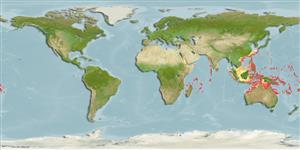Classification / Names
Common names from other countries
Main reference
Size / Weight / Age
Max length : 229 cm SL male/unsexed; (Ref. 9823); common length : 60.0 cm TL male/unsexed; (Ref. 5450); max. published weight: 191.0 kg (Ref. 9710); max. reported age: 32 years (Ref. 51676)
Length at first maturity
Lm ?, range 52 - ? cm
Environment
Marine; reef-associated; depth range 1 - 100 m (Ref. 58652)
Climate / Range
Tropical, preferred ?; 30°N - 23°S
Distribution
Indo-Pacific: Red Sea to South Africa (Ref. 35918) and to the Tuamoto Islands, north to the Ryukyu Islands, south to New Caledonia. Formerly known as Vulnerable (A1d+2cd) (Y. Sadovy) but now listed as Endangered in IUCN 2004 and listed in Appendix II of CITES.
Countries | FAO areas | Ecosystems | Occurrences | Introductions
Short description
Dorsal
spines
(total): 9;
Dorsal
soft rays
(total): 10;
Anal
spines: 3;
Anal
soft rays: 8. Adults of this species develop thick lips and a prominent bulbous hump on the forehead. Juveniles pale greenish with elongate dark spots on scales tending to form bars; 2 black lines posteriorly from eye (Ref. 4392).
IUCN Red List Status (Ref. 115185)
Threat to humans
Reports of ciguatera poisoning (Ref. 5374)
Human uses
Fisheries: minor commercial; aquaculture: commercial; gamefish: yes; aquarium: commercial
More information
ReferencesAquacultureAquaculture profileStrainsGeneticsAllele frequenciesHeritabilityDiseasesProcessingMass conversion
Tools
Special reports
Download XML
Internet sources
Estimates of some properties based on models
Phylogenetic diversity index
PD50 = 0.5078 many relatives (e.g. carps) 0.5 - 2.0 few relatives (e.g. lungfishes)
Trophic Level
4.0 ±0.61 se; Based on food items.
Resilience
Low, minimum population doubling time 4.5 - 14 years (tm = 5-7; tmax = 32)
Vulnerability
High to very high vulnerability (74 of 100)
Price category
